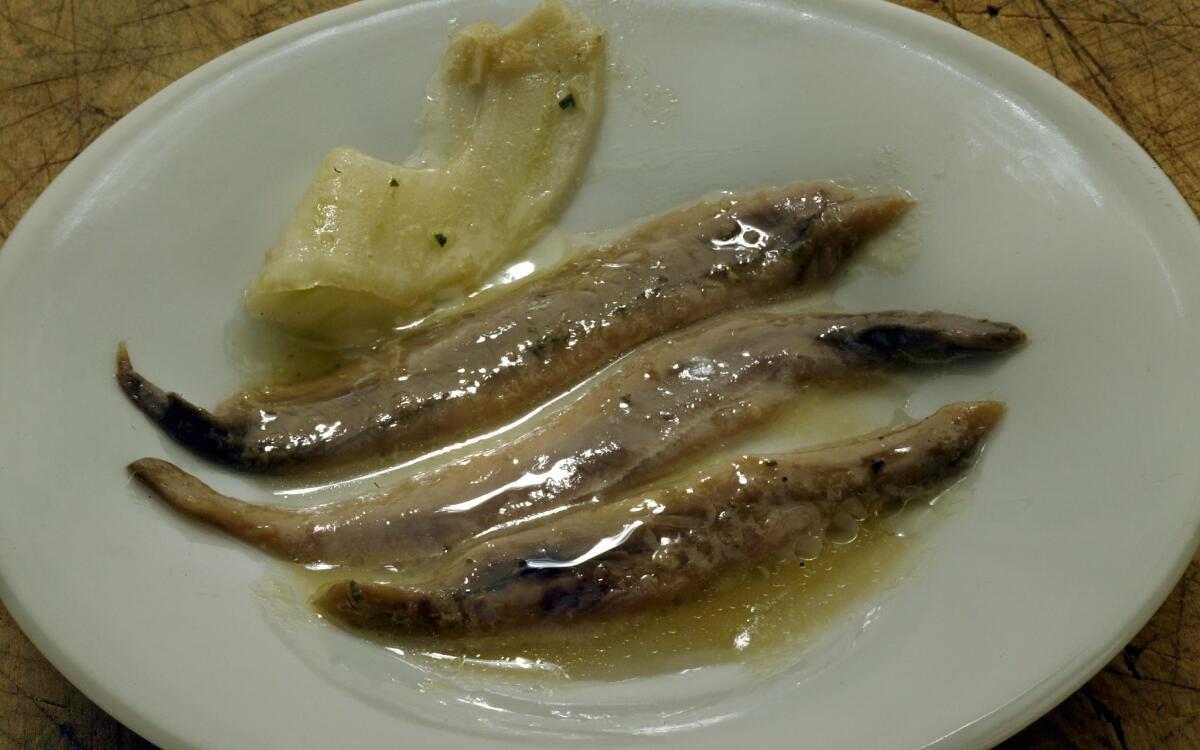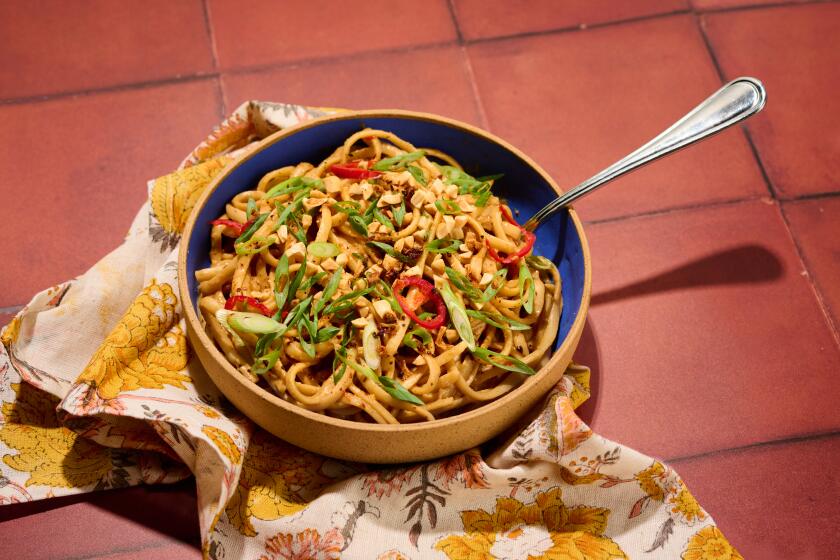Sherry vinegar-cured anchovies

- Share via
Certain foods seem to have sprung, ready-made, from a cosmic conveyor belt to the dining table. Ketchup? It comes from a factory in Pennsylvania. Goldfish crackers? From Pepperidge Farms, right? And lollipops? Worcestershire sauce? Only God can make those.
But lately, L.A. chefs have been taking it upon themselves to reinvent -- and reclaim -- all sorts of foodstuffs that are usually taken for granted. Some, like Chameau chef and co-owner Adel Chagar, who makes his own couscous from semolina as well as a fresh harissa, do it to re-create flavors from far away that don’t travel well. Others, like Naya chef Scooter Kanfer-Cartmill, who serves made-in-house goldfish crackers and exotically flavored lollipops, are doing it for fun -- and because they can.
And for the flavor. When a talented chef or a hard-working kitchen rethinks such seemingly immutable foods as steak sauce, marinated anchovies or ketchup, the result can be a revelation.
While in Spain, munching his way through tapas bars, Sang Yoon, chef-owner of Father’s Office in Santa Monica, was hooked by the marinated white anchovies he ate there. Delicate, soft and variously seasoned with garlic, bay leaves or shallots, they inspired him to cure his own. “I wanted to control the flavor and texture,” he says.
He starts with fresh or drained, oil-packed white anchovies. “The white anchovies available in cans have been sitting in vinegar brine for ages. They become very firm and tart,” he says. He seasons his with a puree of lemon zest, herbs and garlic, then adds Andalusian olive oil and a mixture of the 25-year-old and 8-year-old Spanish sherry vinegars he likes for the woody notes they acquire during aging. A short marinating time keeps the flavors fresh and clear. Yoon makes only small batches and serves the fish -- on grilled country bread with chopped oregano and parsley -- within three days.
Yoon says high-quality Spanish oil and vinegars are essential, although fresh anchovies are not (his suppliers have them only occasionally). But oil-packed white anchovies in bulk (avoid those in smaller cans) are also acceptable. These are usually available at Bay Cities Imports and at Santa Monica Seafood in Santa Monica.
At Chameau, making couscous is a lengthy process and a labor of love that involves passing semolina dough through a series of wood-sided strainers, steaming and lightly drying the grains. But it’s chef Chagar’s harissa, the chile-intense paste that’s North Africa’s favorite condiment, has really caught on.
“My French customers are crazy for our harissa, they order it to go,” says Chagar. Of course, they could buy a commercial version -- “but,” he sniffs, “the ones in tubes and tins contain too many legumes, beets and carrots -- and are not very fresh.”
Chameau’s sauce is really, really fresh -- and potent. Fresh and roasted chiles make it juicier and more pungent than commercially made varieties.
Boa restaurants, the high-style steakhouses that began as Balboa in the Grafton Hotel on Sunset and added branches in Las Vegas and Santa Monica, have a great house-made steak sauce that they’ve dubbed “J-1” after executive chef Josh Thomsen. Served warm in a little pitcher alongside your meat, this steak sauce is lighter and fruitier than bottled varieties, with less acidity and salt, so as not to mask the flavor of the meat. The recipe is based on fresh orange juice, aromatics and unseeded tamarind pulp (whose flavor is closer to the whole pods than tamarind paste or concentrate). Another of the sauce’s components is the kitchen’s own Worcestershire sauce that combines over 50 ingredients including a house-fermented mixture of garlic and anchovies.
Doug Arango’s sumptuous ketchup -- a must-have on the restaurant’s burgers -- captures the essence of sweet vine-ripened tomatoes. “You never have an exact recipe,” says chef Christopher Bennett. He adjusts the seasoning after tasting according to the sweetness of the tomatoes in each batch.
Bennett likes to make variations on the ketchup. He adds a little puree of chipotle chiles to accompany grilled Korean-style short ribs or Southwest-style burgers. Or he’ll add molasses and spices to create a sauce for smoked and roasted meats. For his duck burgers, he adds fresh orange juice and zest.
It’s not just house-made condiments that have chefs working overtime; they’re making candies and confections too. At La Terza, pastry chef Ann Kirk makes her own torrone; it’s crammed with almonds and has a springy, slightly spongy, melt-in-your-mouth texture.
Sweets from Scooter Kanfer-Cartmill, who recently opened Naya, often have a playful theme (as do her savories like the house-made cornmeal-carrot-poppy seed goldfish crackers she often uses to garnish amuse bouches). But her search for ingredients is serious business. Kanfer-Cartmill spent hours trolling the Internet and candy supply sources tracking down and sampling the best flavoring oils with adult taste appeal for her after-dinner lollipops. She prefers good-quality flavored oils to “candy flavorings” and has found some of the best locally at Gloria’s Cake and Candy Supplies in West L.A., Jane’s Cakes in Montrose, Cake Palace in Carson and online at www.getsuckered.com.
“Lollipops are just sugar cooked with water until it will crystallize, so the flavoring is the thing that really defines their character,” Kanfer-Cartmill explains. She enhances her black walnut, maple, caramel and root beer flavors by adding Tahitian vanilla bean scrapings along with the flavoring oil.
The pops are formed simply by pouring small dollops of the cooked and flavored sugar onto a silicone mat or into lollipop molds, also available at the above-mentioned sources.
If you were looking for a way to please your inner child, this is surely the ticket.
In a blender, add the vinegars, olive oil, 1 whole shallot, 2 garlic cloves, the bay leaves and the lemon zest. Blend at high speed until smooth. Keep covered in the refrigerator.
Spoon several tablespoons of the sherry vinaigrette into the bottom of a small glass shallow baking dish. Add a layer of anchovies. Place the sliced shallot, the remaining crushed garlic and the fennel in a bowl; combine. Sprinkle about a third of this mixture over the fish. Pour a few tablespoons of vinaigrette on top. Continue layering. Pour over the remaining vinaigrette and press down gently to submerge the ingredients. Cover and refrigerate for 24 hours.
Get our Cooking newsletter.
Your roundup of inspiring recipes and kitchen tricks.
You may occasionally receive promotional content from the Los Angeles Times.















